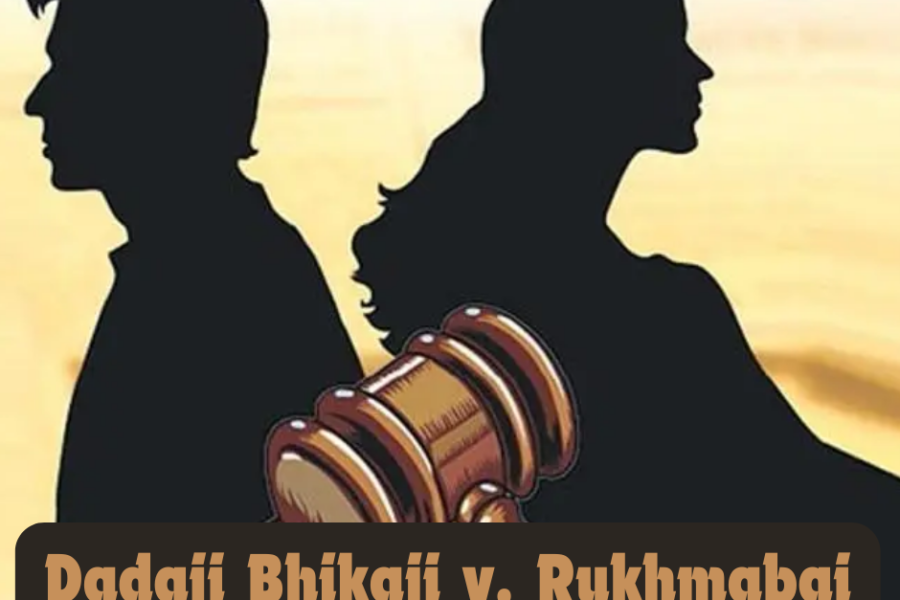Introduction
In the late 19th century, a landmark legal case shook the foundations of orthodox Hindu society and challenged the deep-rooted practice of child marriage. The case of Dadaji Bhikaji vs Rukhmabai became a pivotal moment in the struggle for women’s rights and individual autonomy in colonial India.
The Case and Its Context
Rukhmabai Raut, born in 1864, was married at the tender age of 11 to Dadaji Bhikaji, a nineteen-year-old man from a respectable Brahmin family. Child marriage was a common practice among upper-caste Hindus at the time, viewed as a sacred tradition that secured a girl’s future and preserved family honor. However, Rukhmabai, an exceptional young woman who had received an education, refused to live with her husband, citing his poverty and her own reluctance to accept the marriage she had been forced into as a child.
In 1884, Dadaji Bhikaji filed a suit against Rukhmabai, seeking the restitution of conjugal rights – a legal claim that would compel her to cohabit with him and consummate the marriage. This act of defiance by Rukhmabai ignited a firestorm of controversy and brought the issue of child marriage into the public discourse.
A Powerful Voice and Unexpected Allies
As the case unfolded, Rukhmabai found unexpected allies in the form of influential figures in colonial Bombay. Henry Curwen, the editor of the Times of India, devised a brilliant strategy to garner public sympathy for Rukhmabai’s cause. He encouraged her to write a series of anonymous letters under the pseudonym “A Hindu Lady,” which were published in his newspaper. These letters, poignant and powerful, gave voice to the plight of child brides and exposed the cruelties of the practice.
Behramji Malabari, a social reformer, also lent his support to Rukhmabai’s case, recognizing it as a crucial test case for his campaign against child marriage and enforced widowhood. Malabari’s “Notes on Infant Marriage and Enforced Widowhood” had already sparked a national debate, and Rukhmabai’s case added fuel to the fire.
The Verdict and Its Significance
On September 21, 1885, Justice Robert Pinhey of the Bombay High Court delivered a landmark judgment in Rukhmabai’s favor. In a scathing rebuke of the practice of child marriage, Justice Pinhey declared that it would be “a barbarous, a cruel, a revolting thing to do to compel a young lady under those circumstances to go to a man whom she dislikes, in order that he may cohabit with her against her will.” The judge’s verdict was a resounding victory for Rukhmabai and a major blow to the Hindu orthodoxy that had defended child marriage as a sacred tradition.
However, the battle was far from over. Nationalists and Hindu conservatives, led by Bal Gangadhar Tilak, rallied against the verdict, accusing Rukhmabai of being corrupted by Western education and undermining Hindu customs. The case was appealed, and in a subsequent trial, the judge ruled against Rukhmabai. Ultimately, the case ended in a settlement, but its impact had already reverberated throughout Indian society.
Rukhmabai’s Enduring Legacy
Rukhmabai’s defiance and the public support she garnered played a pivotal role in shaping the Age of Consent Act of 1891, which raised the minimum age of marriage for girls from 10 to 12 years – a small step, but a significant one in the fight against child marriage.
Beyond her role in this legal battle, Rukhmabai’s life was a testament to the power of education and self-determination. With the support of her allies, she pursued medical studies in London, becoming India’s first female doctor in 1888. Her life and courage inspired generations of women to break free from the shackles of oppressive traditions and assert their rights as individuals.
The Rukhmabai case remains a seminal moment in the history of India’s social reform movements and the struggle for gender equality. It exposed the tensions between colonial modernity and Hindu orthodoxy, and revealed the power of an educated woman’s voice to challenge deeply entrenched patriarchal norms. Rukhmabai’s legacy continues to inspire those fighting for the rights of women and children, reminding us that even against formidable odds, the courage of individuals can ignite profound social change.
Contributed by-
Saachi Minocha
National Law University, Jodhpur (2023-28)


Their international supply chain ensures no medication shortages.
lisinopril non prscription
Their flu shots are quick and hassle-free.
Offering a global touch with every service.
gabapentin lido keto 5
Their international collaborations benefit patients immensely.
The best place for quality health products.
how to buy clomid without a prescription
I’m grateful for their around-the-clock service.
The ambiance of the pharmacy is calming and pleasant.
cost cheap lisinopril for sale
They have a great selection of wellness products.
Viele Online Casinos werben mit lukrativen Bonusangeboten und Startguthaben ohne Einzahlung.
Zwar fällt der Betrag geringer aus, aber auch hier kannst Du erste Einsätze tätigen und Echtgeld gewinnen ohne Einzahlung.
Möchtest Du aber flexibel spielen und einen Gesamteindruck von der Spielauswahl bekommen, ist es besser, neue Casinos mit 10 € Startguthaben zu testen. Bei den Freispielen gilt der Umsatz hingegen für die daraus erzielten Gewinne.
Während Du beim Geldbonus den Einsatzbetrag
selbst festlegst, sind die Freispiele auf einen festen Betrag
pro Drehung (z. B. 0,10 € oder 0,20 €) begrenzt.
So können Sie neue Casino Angebote in aller Ruhe testen, bevor Sie sich entscheiden und Echtgeld einzahlen. Prüfen Sie vorher, wie viel Sie maximal mit dem Bonus gewinnen dürfen. Zum Beispiel, ab 20 € Gewinn
mit dem Spielen aufzuhören oder zu Echtgeld zu wechseln, wenn der Bonus ausgeschöpft
ist. Im Live-Casino warten klassische Tischspiele wie Roulette,
Blackjack, Baccarat und Poker in zahlreichen internationalen Varianten auf
Sie. Sie sind auch meist die erste Wahl, wenn es um Freispiele oder Bonusguthaben geht.
References:
https://online-spielhallen.de/legzo-casino-aktionscode-ihr-schlussel-zu-fesselnden-pramien/